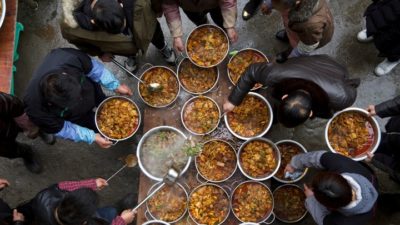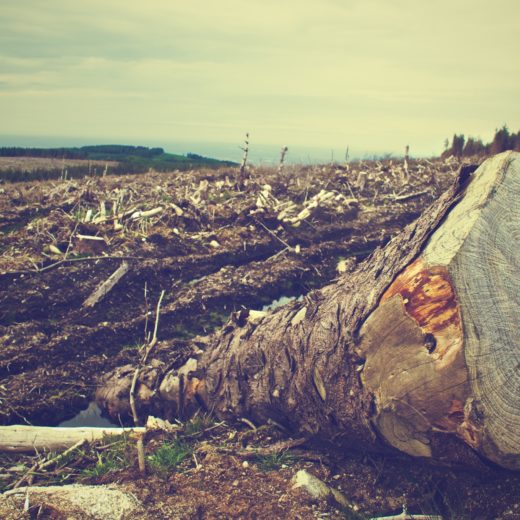


By: MARCELLO ROSSI AND UNDARK
At the center of the table in a modest, high-rise apartment in the teeming city of Shenzhen, China, a simmering pot of soup stock was surrounded by large platters featuring mushrooms, different kinds of thinly shaved meat, lettuce, potato, cauliflower, eggs, and shrimp. Folding his hands together, Zhang Jian, a onetime rural farmer who now works as an employee for a small consulting firm in the city, asked his fellow diners to give thanks for the meal—the likes of which he could have only dreamed of when growing up in a remote village in Jiangxi province.
The reason was simple: His family was so poor that they had to make do with barely sufficient food supplies. “I often went hungry when I was a kid,” said Zhang, his voice betraying the painful memories of a hard childhood. Until the late 1980s, when the state-imposed food-rationing system was phased out from people’s daily lives, food supplies were in serious shortage across China. Coupons for buying basic foodstuffs like grain, flour, rice, oil, and eggs were issued based on monthly rations.
Meat, recalled Zhang as he dipped a piece of beef into the bubbly broth, was a rare luxury that his family could afford “two or three times a month.”
Things have changed remarkably since then. In the past three decades, breakneck industrial development and economic growth have driven millions of Chinese from rural areas to cities, altering much about the Chinese way of life, especially in terms of their day-to-day eating habits—an evolution perhaps most pointedly crystallized in the average Chinese consumer’s access to meat. Once a rare luxury, it has now become a commonplace. “I still remember when beef was nicknamed ‘the millionaire’s meat,’” said Zhang, who reckoned that he spends around 600 yuan, or $88, each week on food, and half of that on meat. “Now I can eat it every day if I want.”
Fueled by rising incomes rather than urbanization, meat consumption in China has grown sevenfold over the past three and a half decades. In the early 1980s, when the population was still under 1 billion, the average Chinese person ate around 30 pounds of meat a year. Today, with an additional 380 million people, it’s nearly 140 pounds. On the whole, the country consumes 28 percent of the world’s meat—twice as much as the United States. And the figure is only set to increase.
But as the Chinese appetite for meat expands, the booming nation is faced with a quandary: How to satisfy the surging demand for meat without undermining the country’s commitment to curbing greenhouse-gas emissions and combatting global warming—goals that have been expressly incorporated into national economic and social development and long-term planning under the Xi Jinping administration.
Raising animals for human consumption, after all, generates climate-changing emissions at every stage of production. For one thing, it requires vast amounts of land, water, and food to raise livestock. For another, cattle are themselves a source of huge quantities of methane, a greenhouse gas much more potent than carbon dioxide. Finally, cattle raising is a major contributor to deforestation, another cause of increases in carbon emissions. Overall, emissions from the livestock industry account for 14.5 percent of total carbon emissions, according to the United Nations Food and Agriculture Organization, and these emissions are likely to increase in the near future as the production of meat is predicted to nearly double in the next 30 years.
With the world’s largest population and a rising craving for meat, China will be one of the biggest sources of increased demand. Experts at the advocacy group WildAid say that average annual meat consumption in China is on track to increase by another 60 pounds by 2030.
“One could argue that Chinese just want to enjoy the kind of life Westerners have for years. In the end, per-capita meat consumption in China is still half that of the United States,” said Pan Genxing, the director of the Institute of Resources, Environment, and Ecosystem of Agriculture at Nanjing Agricultural University. But, he added, “given the sheer population size, even small increases in individual meat intake will lead to outsized climate and environmental consequences worldwide.”
China is already the world’s largest emitter of carbon emissions, accounting for 27 percent of global carbon emissions. Its livestock industry is responsible for producing half the world’s pork, one-fourth of the world’s poultry, and 10 percent of the world’s beef. No one knows exactly how much livestock contributes to the country’s mammoth carbon emissions. The last time Beijing produced official figures, in 2005, it said that the national livestock sector accounted for more than half of the emissions from its overall agricultural activities. But one thing is for sure: How China will deal with soaring demand for meat is of paramount importance to both the nation and the rest of the world.
A 2014 study published in Nature by researchers at the University of Cambridge and the University of Aberdeen stated that to keep up with the demand for meat, agricultural emissions worldwide will likely need to increase by up to 80 percent by 2050—a figure that alone could jeopardize the ambitious plan to keep planetary warming below the 2 degrees Celsius benchmark set under the Paris climate accord.
China would contribute significantly to that growth. Marco Springmann, a sustainability researcher at Oxford Martin School at the University of Oxford, said that if meat consumption in the Asian country keeps growing as predicted, the nation would produce “an additional gigaton of carbon-dioxide equivalents in greenhouse-gas emissions, more than the current emissions of the global aviation industry” alone, and an increase of about one-tenth above China’s current level of emissions. According to a WildAid report, China alone could account for a growth in greenhouse-gas emissions from 1.2 gigatons in 2015 to 1.8 gigatons by 2030.
“These calculations do not include land-use change,” Richard Waite, an associate at the World Resources Institute’s Food Program, told me by telephone from Washington, D.C., “but since meat production—especially beef production—takes up a significant amount of land, growing demand for meat in China would make for more forests converted to agriculture or pasture and also increase pressure on forests elsewhere.”
More meat on tables means more land given over to growing livestock feed—especially soybean, a crucial ingredient used to fatten up hogs and cattle quickly. Agricultural land, however, is in short supply in China. With around 20 percent of the world’s population, the country has only 7 percent of the world’s arable land, which is barely enough to keep up with the government’s goal of being self-sufficient for strategic commodities such as rice, corn, and wheat—a goal that has been at the heart of the national food-security agenda for decades. Moreover, farmland in the country has been shrinking since the 1970s due to urbanization.
The increasing mismatch between available resources and surging demand has pushed China abroad in search of grain to feed livestock. The country now imports more than 100 million tons of soybeans per year, a figure corresponding to more than 60 percent of the global trade. In countries like Brazil, Argentina, and Paraguay this has led to the clearing away of vast swaths of forests to make way for huge soybean monocultures, further driving up greenhouse-gas emissions since forests typically store carbon in living biomasses, soil, dead wood, and litter, while plants sequester vast quantities of carbon dioxide from the atmosphere during photosynthesis.
Importing grains to feed livestock at home isn’t the only strategy China is adopting to bridge the gap. Under the auspices of the government, Chinese companies have been taking over foreign ones like Smithfield Foods, the world’s largest producer of pork. Meanwhile, the Chinese have also been importing meat from Australia, Brazil, Uruguay, Russia, and other countries, making China the world’s single largest market for meat.
“For decades, developed nations have relocated their factories to China, outsourcing their climate pollution and emissions,” said Waite. “Now China seems to have adopted the same paradigm.”
Sure enough, mitigating emissions from one of the world’s largest, and most fragmented, livestock industries isn’t an easy task. It also doesn’t seem to be a priority for Beijing. “Some measures like subsidizing livestock farmers to turn animal waste—a major source of methane and nitrous oxide, two greenhouse gases much more potent than carbon dioxide—into organic fertilizers, encouraging them to take advantage of international carbon trading, or providing financial aid to install biogas plants to produce clean energy from manure have been implemented,” said Pan of the Nanjing Agricultural University. “But no specific low-carbon animal production policies exist in the country today.”
“For now, all the efforts are directed toward cutting emissions from sectors such as power generation and transportation,” he added, “and in the absence of major change, livestock emissions will continue to increase in China in the future.”
Programs aimed at curbing consumer demand for meat have begun to circulate. Two years ago, the Chinese Nutrition Society issued new dietary guidelines, which recommend cutting meat consumption in half, for example. The government also teamed up with WildAid to run celebrity-driven, high-impact media campaigns to promote the benefits of eating less meat. Should these campaigns prove effective, food-related emissions in China could be reduced by a billion metric tons compared to projected levels in 2050, Springmann suggested.
But accomplishing that is no easy feat. While the growth rate of animal-protein consumption in the country has slowed somewhat in the past few years due to a number of factors—including new public-health measures, better alternatives, contaminated meat, and a slowing economy—there are substantial cultural challenges that make it difficult to stem the tide. According to Steve Blake, WildAid’s acting chief in China, most Chinese consumers fail to appreciate the link between higher meat intake and global warming. “While the issue of climate change is accepted in China much more so than in the U.S., the awareness about the impact of diet on climate change is very low,” he said. For a country where older generations “still vividly remember not even being able to afford meat a few decades ago,” he said, “meals featuring high amounts of meat are seen as a very good thing.”
Mixed messages from the government are also a hindrance.
“As is typical with Chinese governmental policy, the right and left hand are fighting against each other,” said Jeremy Haft, the author of Unmade in China: The Hidden Truth about China’s Economic Miracle, in an email message. For example, Haft said, as the government encourages people to eat less meat, it is at the same time shifting the adverse environmental effects of cattle rearing to the United States and other countries, where China continues to invest in agriculture.
But Haft pointed out that China has a rare opportunity to counteract the effects of this surge in meat eating. “China’s remarkable development is regarded by many developing countries to be a model for lifting their own population out of poverty,” he noted. Given its centralized system, it has already proved it can be nimble in response to environmental risks—as happened with the transition away from fossil fuels toward renewable energy, which caused national carbon-dioxide emission rates to remain nearly stable for years leading up to 2017, or with its subsidies for electrical vehicles, which have caused sales to skyrocket.
Now, Haft said, China needs to mount a similar effort to reduce meat consumption.
“If the country wants to become the world’s undisputed leading green superpower, it has to pave the way for a sustainable, low-carbon development [path] for low- and middle-income countries, inspiring them to follow suit,” Haft said. “And reducing emissions from the livestock sector should be part of the path.”
Stay in touch and get the latest WildAid updates.
SIGN UP


